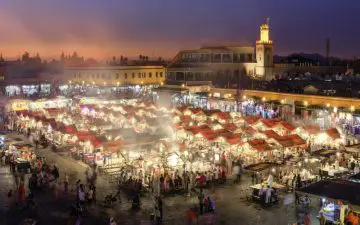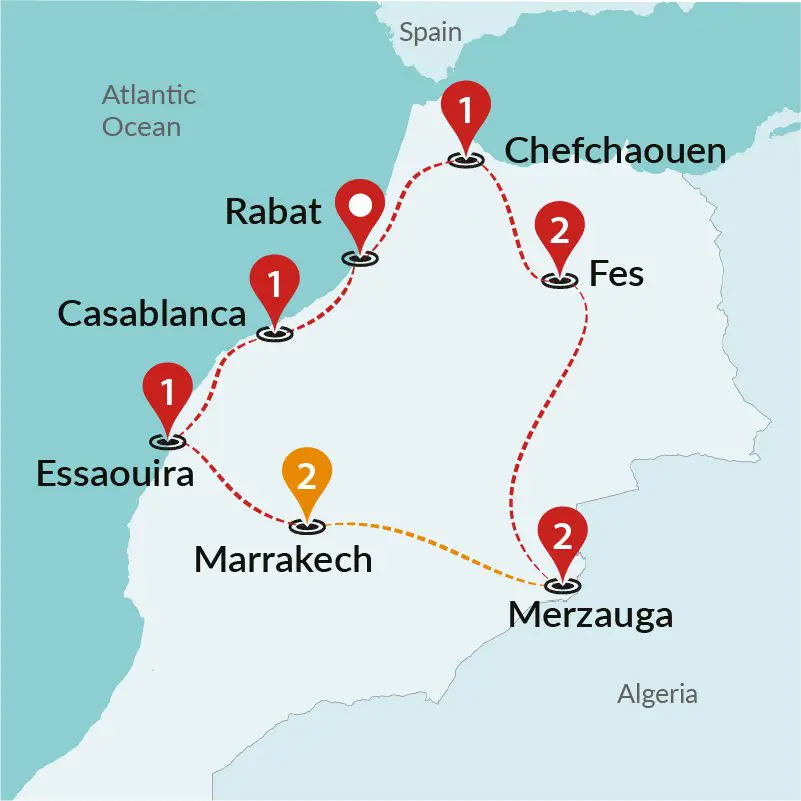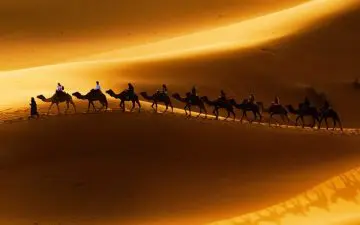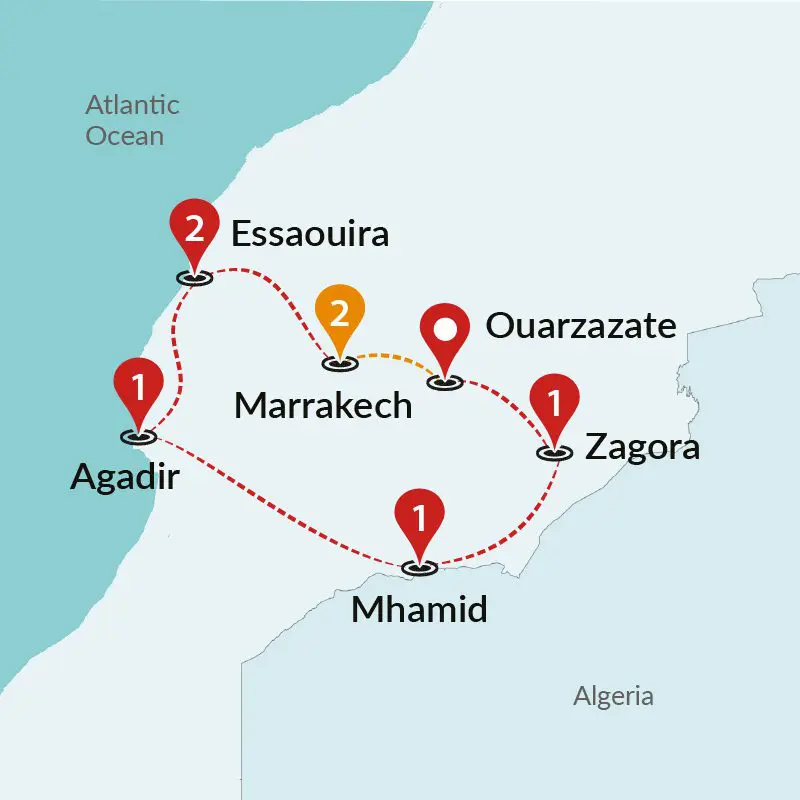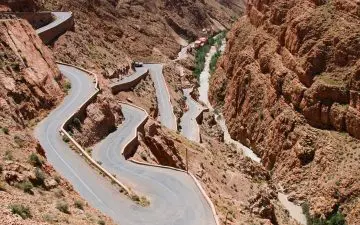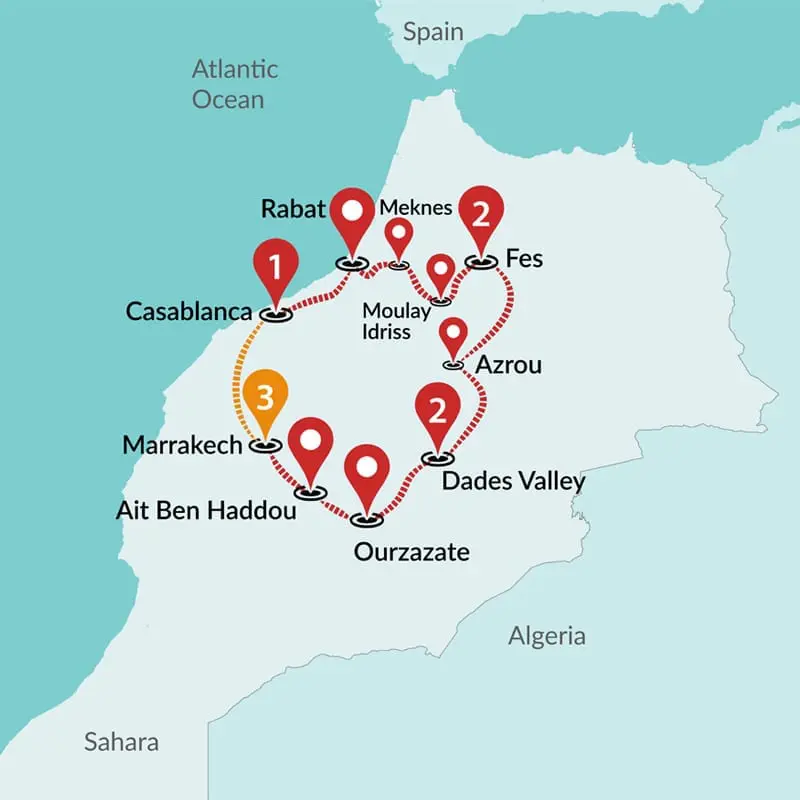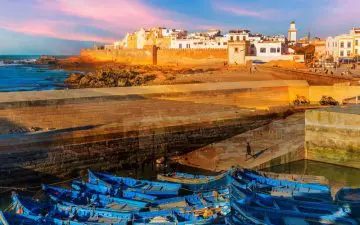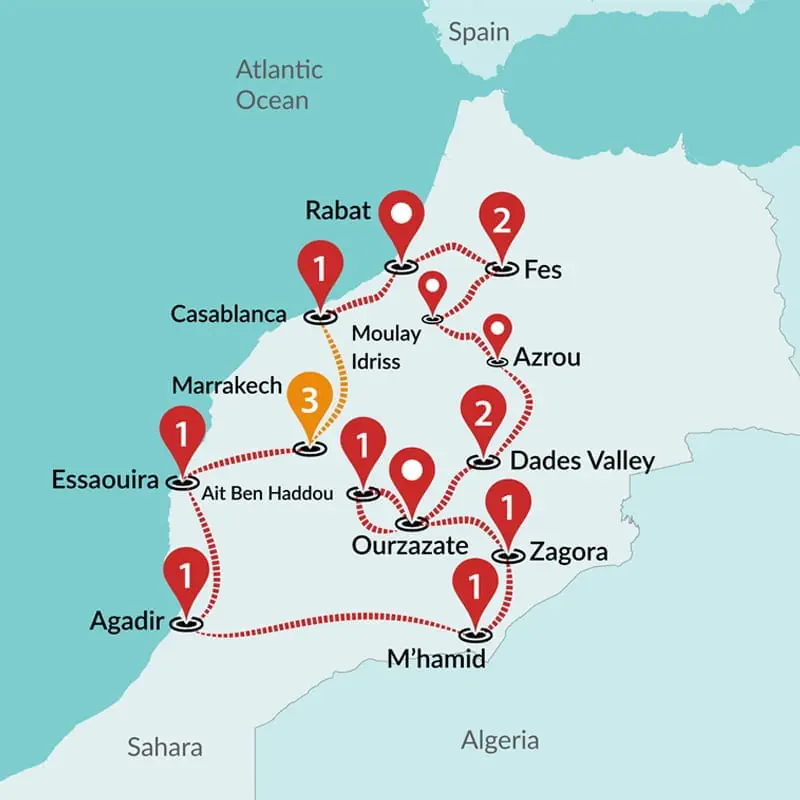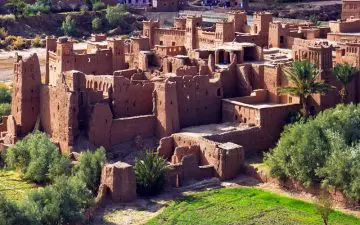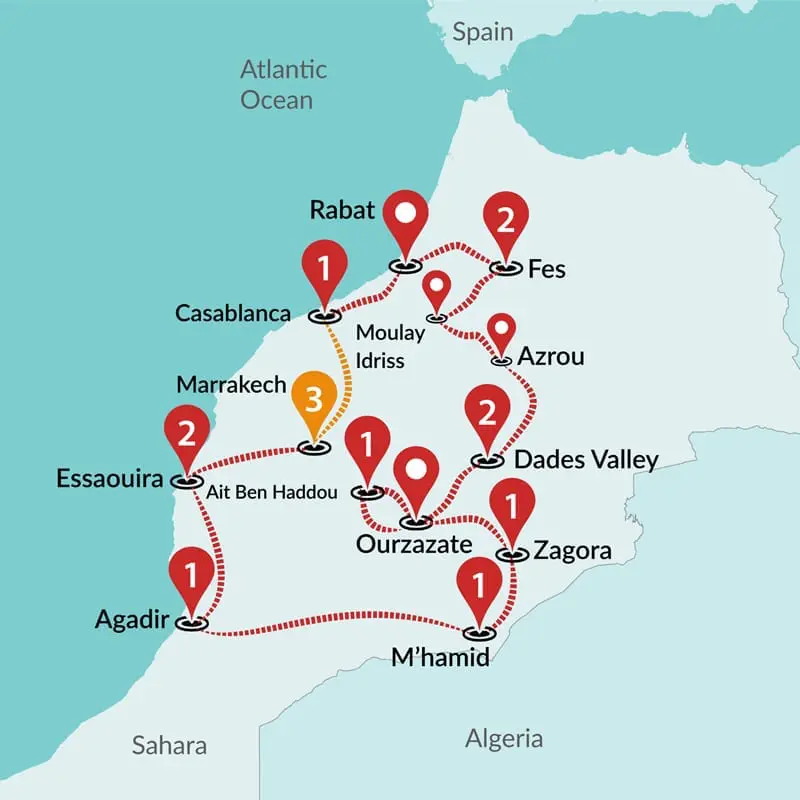Best Time To Visit Morocco
The best time to visit Morocco is in autumn and spring. However, as the country has a diverse geographical landscape, each season has its beauty. In April, May, and September to November, the weather is pleasantly warm across the high grounds of the Atlas Mountains. These are also ideal months for Morocco tours in the south. Southern cities such as Marrakech and Essaouira are warm and sunny, and temperatures become tolerable to visit the Sahara Desert.
Summer months are hot, especially inland and in the Sahara. However, it might be the perfect season for spending time on the Atlantic coast. The beaches are cooler than the inland from June to August, offering the best experience for vacationers. To avoid the heat, visiting the historic sites in the morning is advisable.
In winter, daytime temperatures are moderate, which makes it enjoyable to explore Morocco’s exotic cities. If you visit Morocco in January and February, you might expect to see rainfall on the Atlantic coast. Also, winter might be the ideal season for trips to Morocco if you wish to enjoy a quiet vacation.
Why You Should Travel to Morocco: Morocco is a country that boasts a vibrant culture, diverse landscapes, and a rich history that stretches back centuries. Visitors can explore the bustling markets and intricate architecture of cities such as Marrakech and Fes, or wander through the ancient ruins of Volubilis. Morocco is also home to the stunning Sahara Desert, where visitors can ride camels and camp under the stars. The country’s cuisine is a fusion of African, Arabic, and European influences, offering a tantalizing array of flavors and dishes. With its warm and welcoming people, colorful festivals, and breathtaking natural scenery, Morocco is a destination that promises an unforgettable travel experience.
Things to Consider: Research the country’s customs and culture to understand appropriate attire and behavior. Next, decide which areas of the country you want to explore, as Morocco boasts a diverse landscape ranging from bustling cities to vast deserts. Consider the time of year you plan to visit, as temperatures can vary greatly depending on the region. Additionally, be prepared to negotiate prices when shopping or taking taxis. Finally, don’t miss out on sampling the delicious Moroccan cuisine and immersing yourself in the vibrant local markets.
Monthly Travel Guide For Morocco
Travelling in Morocco in January and February
Daytime temperatures are moderate in Morocco through the winter, but nights can get very cold, especially in the desert and at the high altitudes in the Atlas Mountains. Rainfall is common on the Atlantic Coast, and snow is dominant in the northern cities and the mountains.
If you plan to stay in the desert or camping in the mountains, packing for the cold is recommended. Winter is a great time to visit Morocco for a quiet stay and for experiencing the authentic lives of locals.

Travelling in Morocco in March
March opens the season for hiking in the Atlas Mountains, as the blooming countryside offers the best views. The weather in Morocco is mild but unpredictable in March, so it is best to pack for all weather conditions and check the weather in advance. The ocean temperatures are also lower compared to the summer months.

Travelling in Morocco in April and May
Temperatures begin to rise in April and May across the country, but the weather is still comfortable enough for sightseeing. These months offer the best weather for activities in the Atlas Mountains, in the desert, and on the Atlantic Coast. Temperatures are moderate at this time of year, although occasional showers can be expected.
If you visit the Sahara during these months, keep in mind that desert storms occur around mid-April. April and May is the best time to visit Morocco to avoid the crowds, too.

Travelling in Morocco in June
Around June, daily temperatures begin to go up, but visiting the desert is still ideal before July brings the scorching heat. Coastal cities such as Rabat and Essaouira benefit from the ocean breeze throughout summer.
The most popular destinations in Morocco do not get crowded until the European summer holiday begins, so you can enjoy some quiet time in June.

Travelling in Morocco in July and August
July and August are the hottest months in Morocco, with the daytime temperatures reaching 100°F in southern cities, such as Marrakech. The Atlantic Coast offers pleasant weather in these months, and the high altitudes of the Atlas Mountains can provide shelter from the heat. Visiting the historic sites and exploring the city is comfortable in the early morning and after sunset.
The Sahara desert is not ideal for visiting during these months. The difference between day and night temperatures reaches a dramatic level. Yet, Summer is one of the most crowded times in Morocco, and festivals take place across the country.

Travelling in Morocco in September
Desert trips in the Sahara become comfortable again as temperatures cool down in September. Visiting the beaches and the landmarks are also pleasant during this time after the crowds leave the country.
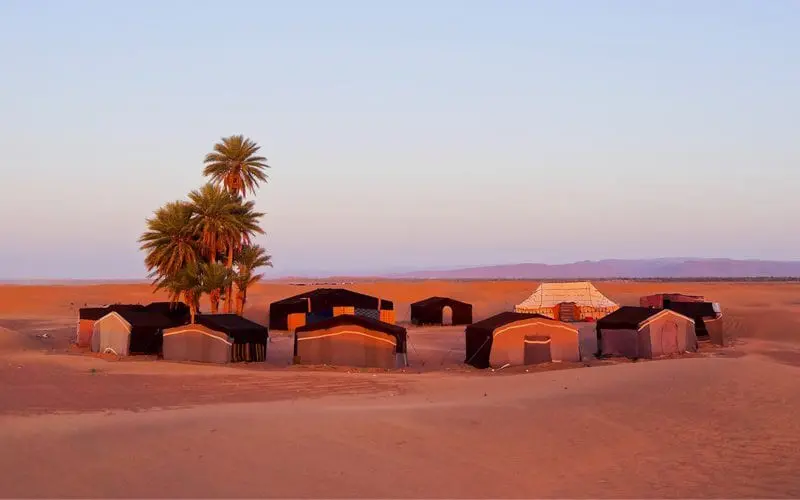
Travelling in Morocco in October
Similar to the spring season, October offers the best time to visit Morocco. The weather is warm and sunny without excessive heat, and the clear blue sky offers fascinating views. It is also one of the busiest times, so booking early is recommended.
Staying in the Sahara Desert is comfortable, and it is a great time to enjoy the authentic activities in the cities.

Travelling in Morocco in November & December
November is the last month before hiking in the higher regions of the Atlas becomes demanding due to snowfall. However, it is a great month to discover what the majestic cities of Morocco have to offer.
Ocean breeze gets strong on the coast, so temperatures are slightly lower than inland in these months. Packing for colder weather is advisable if you are visiting Morocco in November-December.
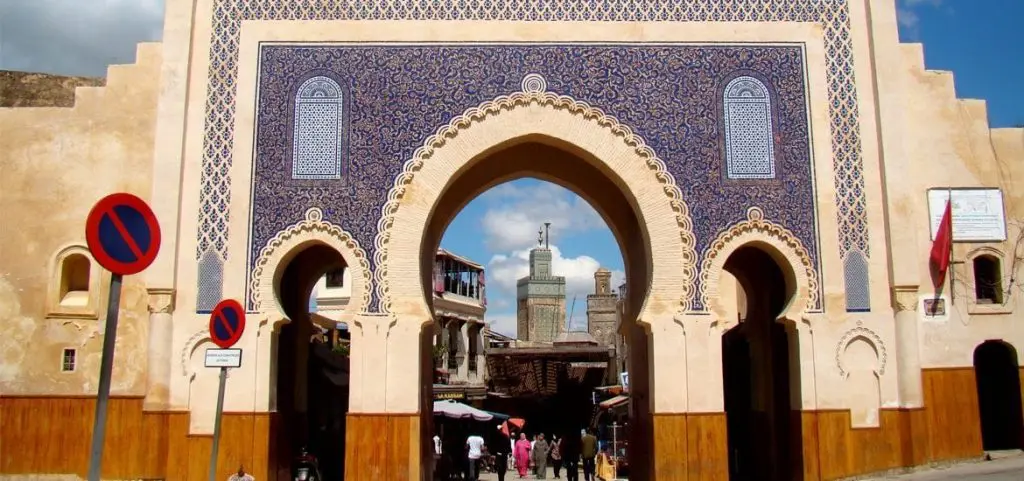
Morocco Climate & Weather Guide
You may find below the average temperatures, rainfall and snowfall in Morocco.
| Destination | Jan | Feb | Mar | Apr | May | Jun | Jul | Aug | Sep | Oct | Nov | Dec | ||
|---|---|---|---|---|---|---|---|---|---|---|---|---|---|---|
| Marrakech | 🔆 | 13°C | 14°C | 17°C | 18°C | 21°C | 25°C | 30°C | 29°C | 27°C | 21°C | 17°C | 14°C | |
| 🌧️ | 32 mm | 38 mm | 38 mm | 39 mm | 24 mm | 5 mm | 1 mm | 3 mm | 6 mm | 24 mm | 41 mm | 13 mm | ||
| ❄️ | – | – | – | – | – | – | – | – | – | – | – | – | ||
| Essaouira | 🔆 | 17°C | 18°C | 19°C | 19°C | 20°C | 23°C | 26°C | 26°C | 23°C | 22°C | 20°C | 18°C | |
| 🌧️ | 45 mm | 40 mm | 35 mm | 30 mm | 10 mm | 2 mm | – | 1 mm | 5 mm | 25 mm | 50 mm | 55 mm | ||
| ❄️ | – | – | – | – | – | – | – | – | – | – | – | – | ||
| Ouarzazate | 🔆 | 10°C | 12°C | 16°C | 20°C | 23°C | 28°C | 31°C | 30°C | 27°C | 21°C | 15°C | 11°C | |
| 🌧️ | 20 mm | 40 mm | 20 mm | 7 mm | 5 mm | 7 mm | 4 mm | 10 mm | 10 mm | 20 mm | 20 mm | 20 mm | ||
| ❄️ | – | – | – | – | – | – | – | – | – | – | – | – | ||
| Casablanca | 🔆 | 13°C | 13°C | 15°C | 16°C | 18°C | 20°C | 24°C | 24°C | 24°C | 20°C | 17°C | 14°C | |
| 🌧️ | 60 mm | 70 mm | 50 mm | 40 mm | 20 mm | 10 mm | 10 mm | 10 mm | 10 mm | 30 mm | 60 mm | 50 mm | ||
| ❄️ | – | – | – | – | – | – | – | – | – | – | – | – | ||
| Agadir | 🔆 | 15°C | 16°C | 19°C | 19°C | 20°C | 23°C | 27°C | 27°C | 23°C | 22°C | 19°C | 16°C | |
| 🌧️ | 37 mm | 29 mm | 25 mm | 13 mm | 7 mm | 1 mm | – | 1 mm | 1 mm | 22 mm | 29 mm | 63 mm | ||
| ❄️ | – | – | – | – | – | – | – | – | – | – | – | – | ||
| Fes | 🔆 | 10°C | 10°C | 13°C | 16°C | 20°C | 24°C | 27°C | 28°C | 24°C | 20°C | 14°C | 10°C | |
| 🌧️ | 58 mm | 58 mm | 65 mm | 66 mm | 50 mm | 18 mm | 4 mm | 8 mm | 33 mm | 61 mm | 70 mm | 58 mm | ||
| ❄️ | – | – | – | – | – | – | – | – | – | – | – | – | ||
| Rabat | 🔆 | 13°C | 14°C | 14°C | 16°C | 18°C | 21°C | 24°C | 24°C | 22°C | 20°C | 16°C | 14°C | |
| 🌧️ | 77 mm | 74 mm | 61 mm | 62 mm | 25 mm | 7 mm | – | – | 6 mm | 44 mm | 97 mm | 101 mm | ||
| ❄️ | – | – | – | – | – | – | – | – | – | – | – | – |
When to visit Morocco
Visit the Atlas Mountains in Autumn
Although the Atlas Mountains are available all year, longer hikes are uncomfortable due to excessive heat in the summer. Still, it is an ideal season for short early morning treks. September and October are the best times for trekking and hiking, as high temperatures in the valleys leave their place to the mountain breeze and the weather in Morocco is ideal. For camping and longer trips in the mountains, packing for cold nights would be ideal.
Tips for visiting the Atlas in autumn:
– Things to pack for Morocco: Pack warm layers, a rain jacket for unpredictable weather, and comfortable shoes for hiking.
– Plan your hikes and other outdoor activities considering the short days and early sunset.
– Stay hydrated, avoid alcohol, and take it easy during the first few days of your visit.
– Be respectful: The Atlas Mountains are home to Berber communities with their own customs and traditions.
– The Atlas Mountains are known for their rich culture and traditions. Consider attending a local festival or market, watching a traditional dance performance, or learning about the local music.
– The Atlas Mountains are a remote and rural area, so it’s important to be prepared for limited amenities.The Atlas Mountains are a remote and rural area, so it’s important to be prepared for limited amenities.
Visit the Sahara Desert in April and May
Early winter is one of the best times to visit the Sahara, as the daytime temperatures are moderate, but the nights can get extremely cold. Also, through February to mid-April, the desert sandstorms are dominant in the region. April to May is the ideal time to visit the Sahara when you can stay in Desert Camp, take camel treks, and jeep safari with our Adventure Morocco tour.
Ramadan, the holy month celebrated in Islam, mostly takes place in the spring or the start of June. Trips to Morocco during this month offer a fascinating insight into the Islamic culture, but there might be restrictions in the opening hours of many shops and restaurants.
Tips for visiting the Sahara in the spring:
– Drink plenty of water when visiting the Sahara, especially during the hotter parts of the day.
– Sandstorms are common in the spring. Be prepared with a scarf or mask to cover your face and protect your lungs from the sand.
– The Sahara is a Muslim region, so it’s important to be aware of local cultural norms. Dress modestly, avoid public displays of affection, and be mindful of the local customs regarding alcohol.
– Avoid leaving any trash behind, stick to designated trails, and be respectful of local wildlife.
– Things to pack for Morocco: Bring sturdy shoes or boots, a hat, sunglasses, and sunscreen to protect yourself from the sun. Also, bring plenty of water and snacks.
Visit the Moroccan Cities in October
October is the perfect month for Morocco tours. You can avoid the cold winter nights and the continental heat. It also offers the ideal weather for visiting the Atlas Mountains, the Sahara, the Atlantic Coast, and especially the cities. The colorful Moroccan cities like Fes celebrate the harvest season with numerous festivals in fall, the most spectacular one being the Erfoud Date Festival. Our Exotic Morocco tour offers insight into the authentic cities of Casablanca and Marrakech, which can be visited from April to November.
Tips for visiting Morocco in October:
– October can still be warm enough for a dip in the sea! Morocco has some beautiful beaches to explore in Essaouira and Agadir.
– Consider booking your accommodations and tours in advance to avoid any last-minute surprises.
– Things to pack for Morocco: Be sure to pack layers and a waterproof jacket or umbrella, especially if you plan to visit the mountains or coastal areas.
– Be sure to try some of the local dishes and street food during your visit.
– Be sure to drink plenty of water, wear sunscreen, and protect yourself from mosquito bites to avoid getting sick during your visit.
Visit the Atlantic Coast in Summer
Summer months are the best time to visit Morocco and enjoy the hotels, resorts, and sun-kissed beaches of the Atlantic Coast. Since it is the holiday season in most of the northern hemisphere, most Morocco tours take place in the summer. The coast is likely to be crowded, making it a perfect time for those who are looking for a lively atmosphere.
One of the most popular coastal cities is Essaouira, offering relatively cooler temperatures, excellent seafood, and a memorable cultural feast. As for the surfing hotspots, spring and summer are still ideal seasons to catch waves. But those looking for bigger ones should visit surf destinations like Agadir in winter.
Tips for visiting the Moroccan coast in the summer:
– Be sure to drink plenty of water and stay out of the sun during the hottest part of the day.
– Morocco is known for its delicious seafood, and you’ll find plenty of fresh options at the coastal restaurants.
– It’s not common to wear bikinis or swimwear in public areas outside of the beach, so consider bringing a cover-up.
– To avoid the hottest part of the day, consider visiting the beach early in the morning or later in the afternoon when the temperatures are cooler.
Morocco FAQ
What’s the cheapest time to go to Morocco?
In the low season from May to September, you can find lower prices on accommodation and transportation as well as fewer crowds at tourist sites. This is the cheapest time to visit Morocco for budget travelers. If you’re sensitive to heat, you may want to consider traveling during the shoulder season which is from March to April, and from October to November when the weather is milder and prices are still relatively low.
What is the hottest month in Morocco?
The hottest month in Morocco is typically July, although August can also be very hot. During these months, temperatures can reach up to 38-40 degrees Celsius, particularly in inland areas such as Marrakesh, Fez, and the Sahara Desert. Coastal cities such as Casablanca, Rabat, and Essaouira tend to be somewhat cooler due to the sea breeze.
What is the best month for a quiet visit to Morocco?
The best month for a quiet visit to Morocco would be during the low season, which is from May to September. During this time, there are fewer tourists, and you’ll be able to explore the country at a more relaxed pace.
In particular, May and June are great months to visit Morocco if you’re looking for a quieter experience. The weather is warm but not too hot, and the crowds are generally smaller than during the peak season.
When is the best time to attend a Moroccan festival or event?
One of the most famous events in Morocco is the Fes Festival of World Sacred Music, which takes place in the city of Fes in June. If you are a music enthusiast, this is a perfect event to experience. If you’re interested in traditional Moroccan culture, the best time to attend a festival would be during Ramadan, which is the holy month of fasting for Muslims.
Another popular event is the Marrakesh International Film Festival, which usually takes place in December.
Why should I travel to Morocco during Ramadan?
You’ll see colorful street festivals, musical performances, and nightly feasts where locals break their fast. You’ll also have the chance to taste traditional Moroccan foods that are served during Ramadan.
While the cities may be lively at night during Ramadan, the days can be very quiet and peaceful as many businesses close during the day. This can be a great time to explore the local markets and tourist sites without the crowds.
When is the best time to visit Morocco for outdoor activities?
The best time to visit Morocco for outdoor activities is during the shoulder seasons of spring and fall (March to May and September to November).
Some popular outdoor activities in Morocco include hiking in the Atlas Mountains, camel trekking in the Sahara Desert, and surfing on the Atlantic Coast. During the shoulder seasons, temperatures are comfortable for these activities, and you’ll avoid the peak season crowds.
When is the best time to visit Morocco to experience the Islamic tradition?
If you’re interested in experiencing the Islamic tradition in Morocco, the best time to visit is during the holy month of Ramadan. Ramadan in Morocco is between April 1st and April 30th, 2023.
There are also other important Islamic holidays and festivals that you can experience in Morocco, such as Eid al-Fitr and Eid al-Adha. These festivals are marked by prayers, feasting, and family gatherings
How many days do I need to visit Morocco?
The number of days needed to visit Morocco depends on several factors such as your travel style, itinerary, and interests. If you plan to visit only the major cities such as Marrakech, Fes, and Casablanca, a week (7 days) would be enough to explore their main attractions and get a taste of Moroccan culture. If you want to visit the Sahara Desert and take a camel trek, explore the coastal towns such as Essaouira and Agadir, and explore the Atlas Mountains and go hiking, a 10-12 day itinerary is ideal.
What is the rainiest month in Morocco?
In general, the rainy season in Morocco is from November to March, with the heaviest rainfall occurring in December and January. During this time, the northern and coastal regions of Morocco receive the most rainfall, while the southern parts of the country are generally drier.
However, some regions have their own distinct weather patterns. For example, the Sahara Desert receives very little rainfall throughout the year, while the Atlas Mountains experience heavy snowfall during the winter months.
What is the coldest month in Morocco?
The coldest month in Morocco is January, especially in the northern and central regions. During this month, temperatures can drop to around 5-10°C (41-50°F) during the day and below freezing at night. The cities of Marrakech and Fes, which are popular tourist destinations, can also experience chilly temperatures during this month.
However, some regions have their own distinct weather patterns. For example, the Atlas Mountains experience heavy snowfall during the winter months, and temperatures can drop well below freezing.
What are the best cities to visit in Morocco?
Marrakech: Known as the “Red City,” Marrakech is one of Morocco’s most famous and vibrant cities.
Fes: Known as the “cultural capital” of Morocco, Fes is an ancient city with a rich history and stunning architecture.
Casablanca: The largest city in Morocco, Casablanca is a modern city with a cosmopolitan vibe.
Chefchaouen: A picturesque blue-painted city in the Rif Mountains, Chefchaouen is a popular destination for its charming streets.
Essaouira: A coastal city with a rich history, Essaouira is famous for its ancient fortifications.
Other notable cities to consider visiting in Morocco include Rabat (the capital city), Tangier, and Ouarzazate (known as the “Gateway to the Sahara”).
Is it safe to travel to Morocco?
Morocco is generally a safe country to travel to, and millions of tourists visit each year without incident. However, like any destination, there are some safety concerns to keep in mind. With some basic precautions and awareness, travelers can have a safe and enjoyable trip to Morocco.
What Are The Most Beautiful Places In Morocco?
The vast and awe-inspiring Sahara Desert is a must-see destination in Morocco. The charming and picturesque blue-painted streets of Chefchaouen make for a stunning and unforgettable sight. The High Atlas Mountains offer breathtaking scenery, including snow-capped peaks, lush valleys, and traditional Berber villages. Located in the Atlas Mountains, the Dades Gorges are a series of stunning canyons and cliffs that offer dramatic and otherworldly views. This ancient fortified village, located on the edge of the Sahara, is a UNESCO World Heritage Site and a striking example of traditional Moroccan architecture.
Does Morocco have nightlife?
Yes, Morocco has a nightlife scene, particularly in major cities such as Marrakech, Casablanca, and Tangier. While the nightlife in Morocco may be different from what you’re used to, it can still be lively and enjoyable.
Morocco has several nightclubs, particularly in Casablanca, that are popular among locals and tourists alike. These clubs often feature live music and DJs playing a mix of Western and Arabic music. It’s essential to keep in mind that nightlife in Morocco may have different cultural norms and expectations than what you’re used to, so it’s always a good idea to be respectful and aware of local customs.
What is the best time to eat delicious food in Morocco?
Moroccan cuisine is a blend of Arab, Berber, and Mediterranean flavors, and dishes are often served with fresh herbs, spices, and vegetables. Some popular Moroccan dishes include tagine, couscous, and harira soup. Ramadan is also a great time to enjoy Moroccan food, as many restaurants and cafes offer special menus during this time.
Do you need a visa to visit Morocco?
Whether or not you need a visa to visit Morocco depends on your nationality and the length of your stay. Citizens of some countries, such as the United States, Canada, the United Kingdom, and many European Union countries, do not need a visa to enter Morocco for stays of up to 90 days. However, visitors from other countries may need to obtain a visa before traveling to Morocco. It’s always best to check with the Moroccan embassy or consulate in your country to determine if you need a visa or any other travel requirements before planning your trip.
What to wear in Morocco?
Morocco is a conservative country, and it’s important to dress appropriately to show respect for the local culture and customs. While there is no strict dress code for tourists, it’s best to avoid clothing that is revealing or provocative. For women, it’s recommended to wear loose-fitting clothing that covers the shoulders, arms, and legs. Long skirts, dresses, or pants with a tunic top are a good choice. Men should also avoid wearing shorts, and it’s recommended to wear long pants and a shirt with sleeves. It’s also a good idea to bring a scarf or shawl to cover your head and shoulders when visiting mosques or other religious sites. During the summer months, it can get quite hot in Morocco, so lightweight and breathable fabrics such as cotton and linen are ideal.
Morocco by Season

Winter
This winter, take the opportunity to experience Morocco at its rawest state. Tourist crowds are rarely found in popular Moroccan destinations during this season. This means that you will get to observe local life and age-old traditions without haste.
One of the best times for visiting the Sahara is winter. Enjoy the mild temperatures and a night sky as clear as glass free from sandstorms and the dust of the desert.
Best Things to do in Morocco in winter:
Visit a traditional Moroccan hammam to unwind during the cold winter months.

Spring
The best time to trek the Atlas Mountains in Morocco is the blossoming April and May. You will capture some of the most striking landscape photographs of a lifetime. Some highlight views are young almond trees and cherry flowers. Also, the streams and rivers are flowing wildly due to snow melt.
Ramadan is in the spring of 2023. You will have the best experience of authentic Moroccan traditions and Islamic culture if you visit Morocco in the spring.
Best Things to do in Morocco in spring:
Attend the Rose Festival in the Dades Valley, one of the most iconic destinations in Morocco. Shop for giftable Moroccan treats in the bustling souqs of Fes and Marrakech.

Summer
The true mojo of the Atlantic coast of Morocco unravels in the summer months. From June to August, take some time off on the trendy beaches of Essaouira and Agadir. Also, you will witness the liveliest time in Morocco due to the summer holidays.
Best Things to do in Morocco in summer:
Attend the Gnaoua World Music Festival and revel in some mystical tunes. Visit a Berber village in the valleys of the Atlas Mountains.

Autumn
The imperial cities of Morocco, such as Marrakech, Rabat, and Fes, take on a different color in the fall. The harvest season and the changing countryside give way to spectacular views along with a unique festive vibe.
Fall is the perfect time to sample Morocco’s delicious cuisine, with a wide range of seasonal dishes available.
Best Things to do in Morocco in autumn:
Stay in a traditional Berber desert camp. Try tagine, a slow-cooked stew made with meat or vegetables, or harira, a spicy soup traditionally served during Ramadan.
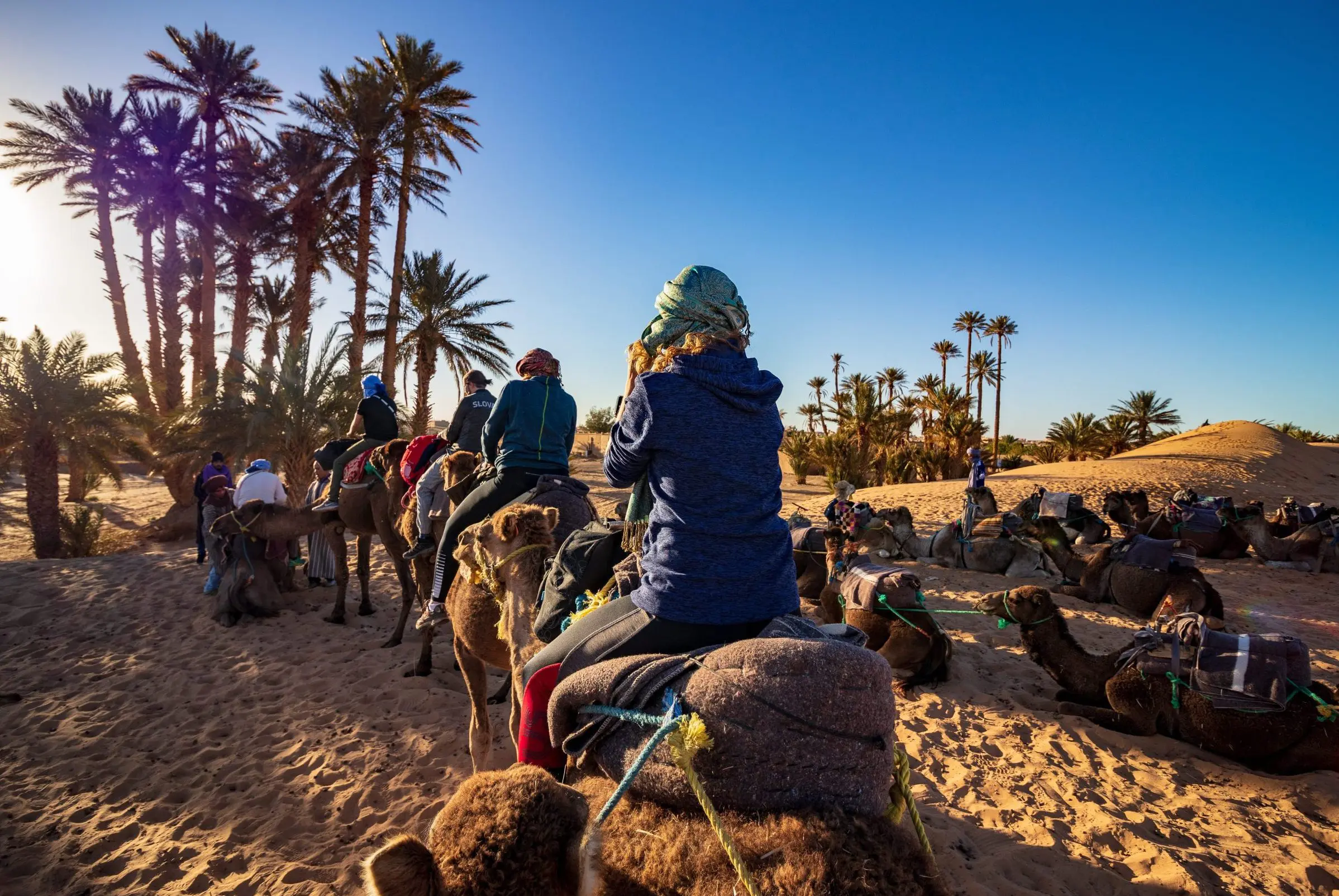 Summer Sale: 45% Off
Summer Sale: 45% Off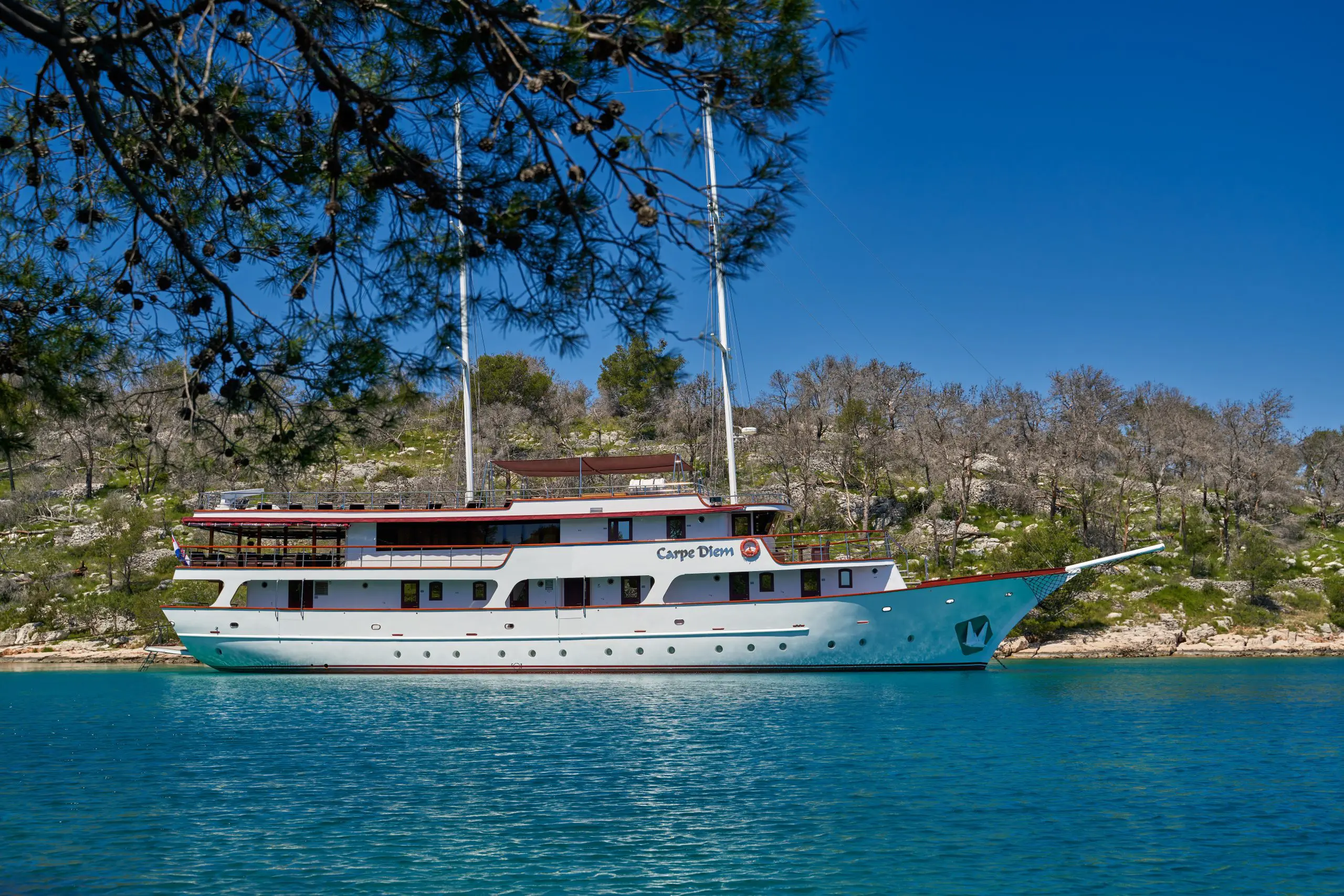 Croatia Sailing : 45% Off
Croatia Sailing : 45% Off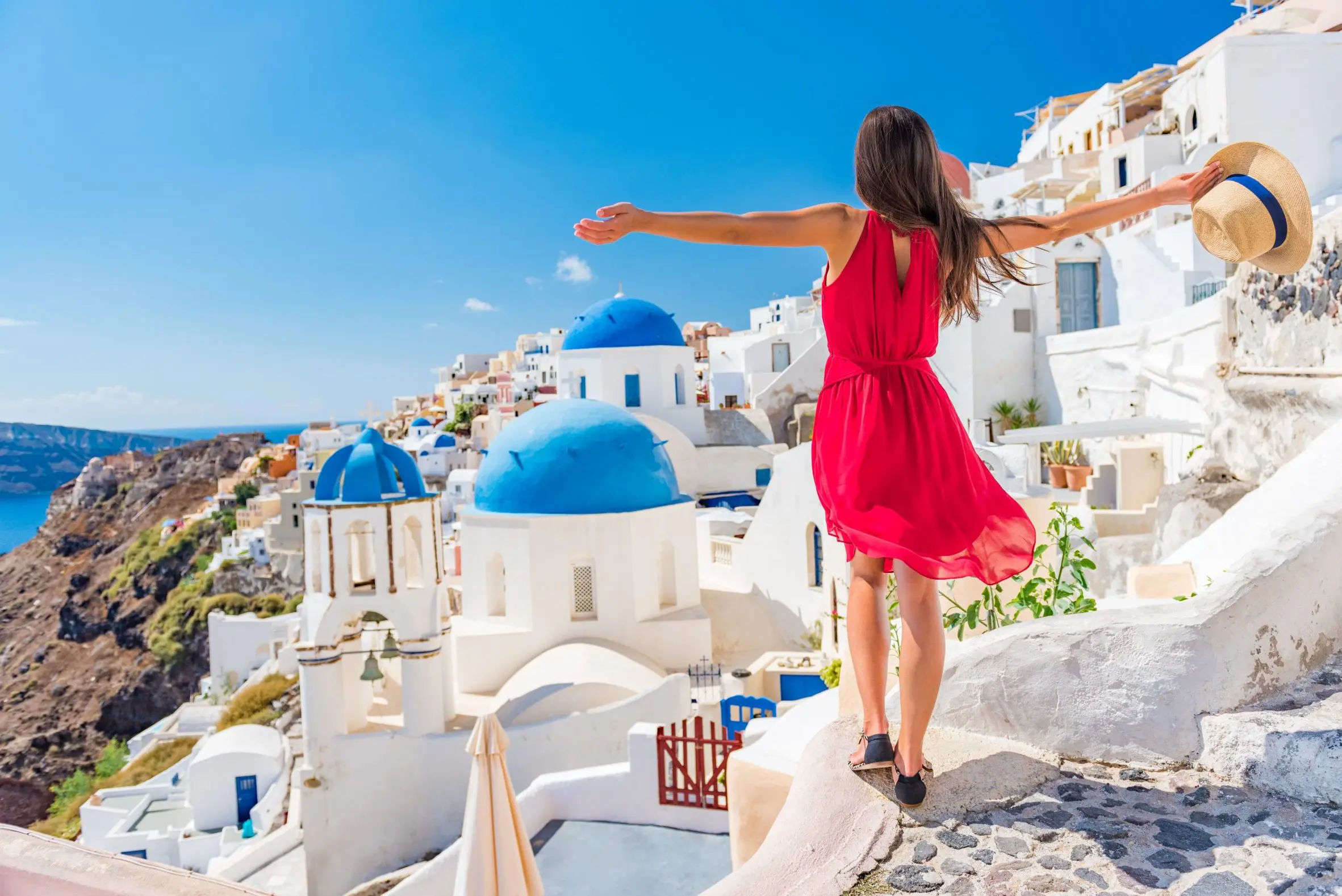 Greece Trips : Save 45%
Greece Trips : Save 45% 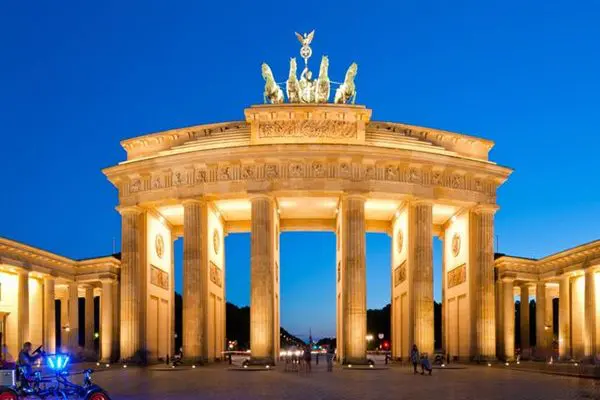 Central & Eastern Europe Tours: 45% Off
Central & Eastern Europe Tours: 45% Off 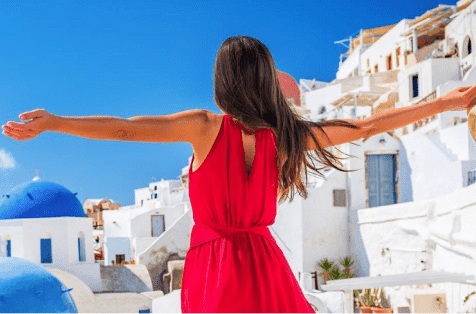 Why Travel Talk
Why Travel Talk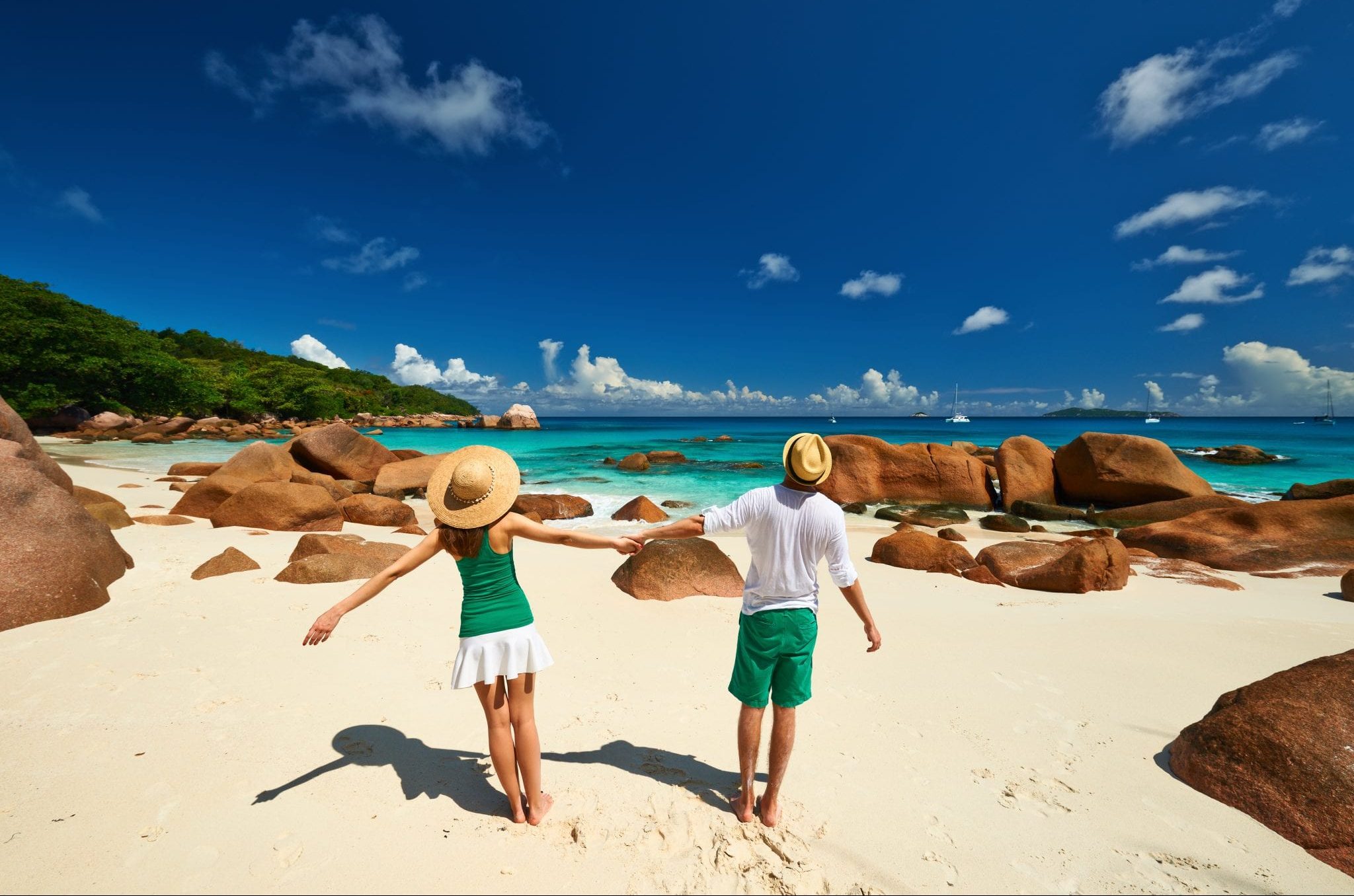 Travel Talk Blog
Travel Talk Blog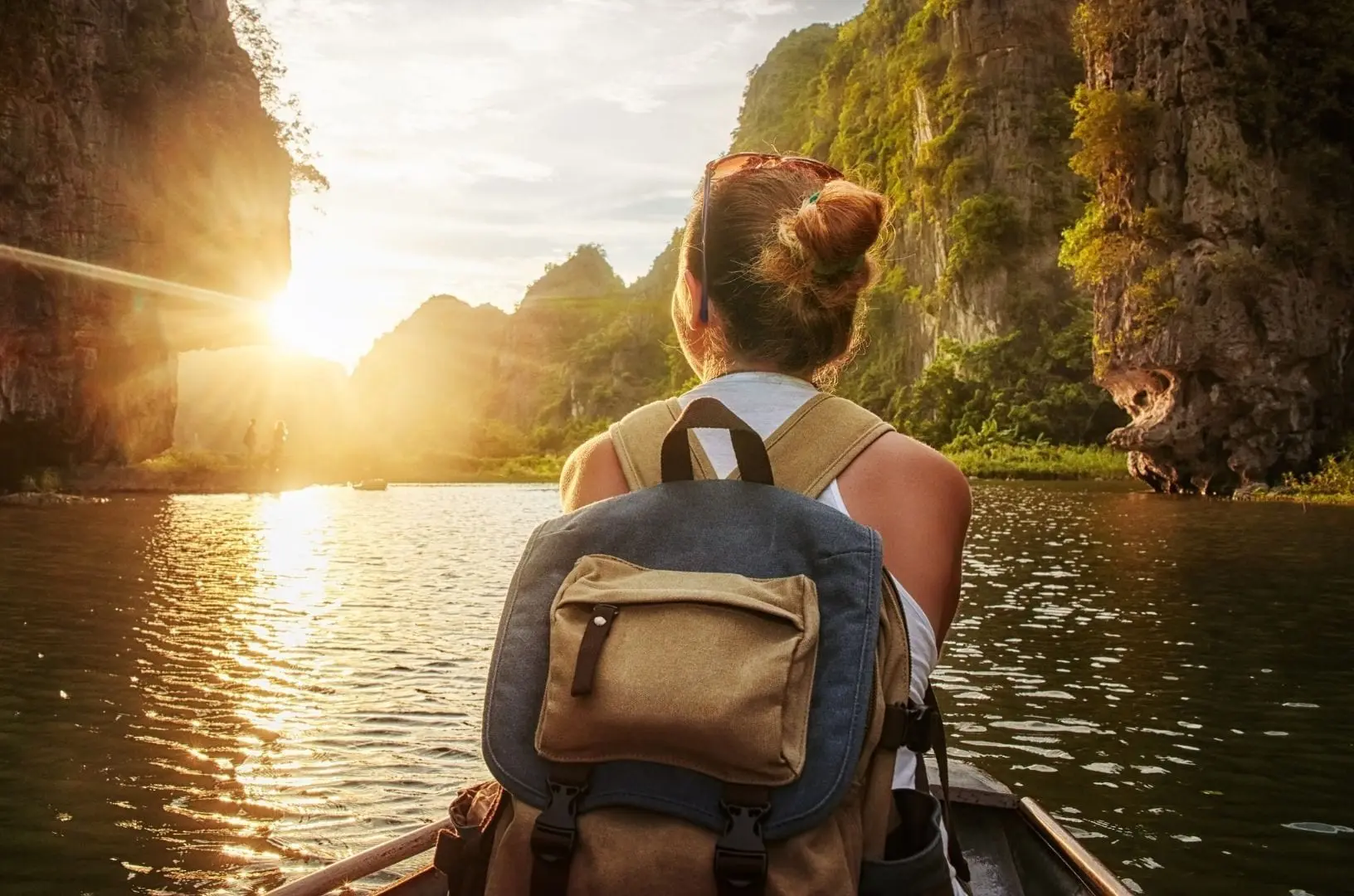 Responsible Travel
Responsible Travel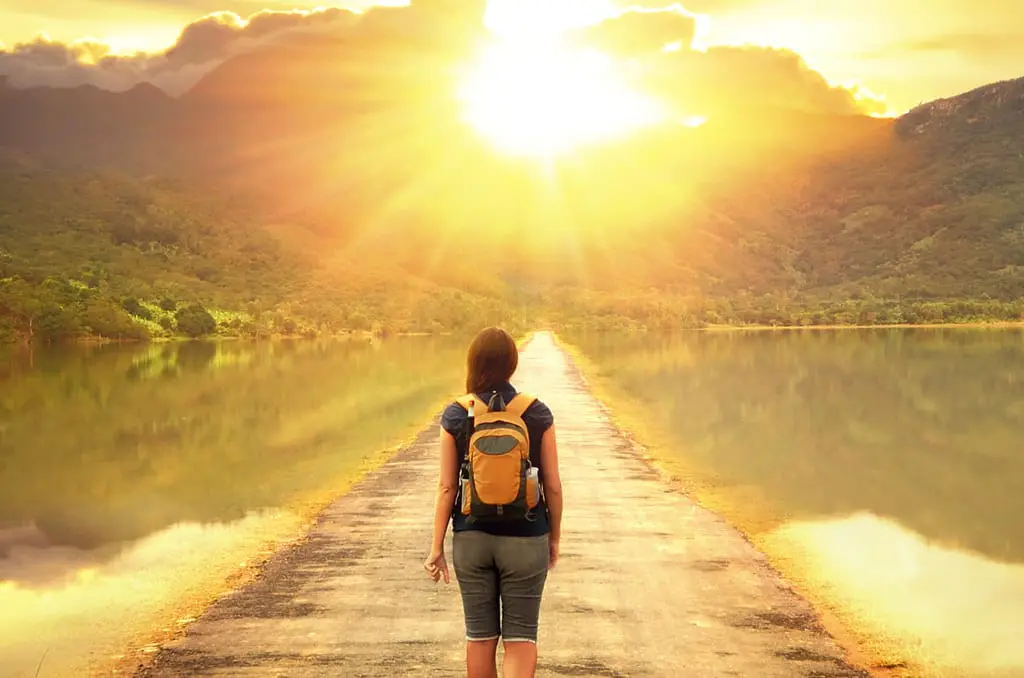 Fair Travels with Travel Talk
Fair Travels with Travel Talk